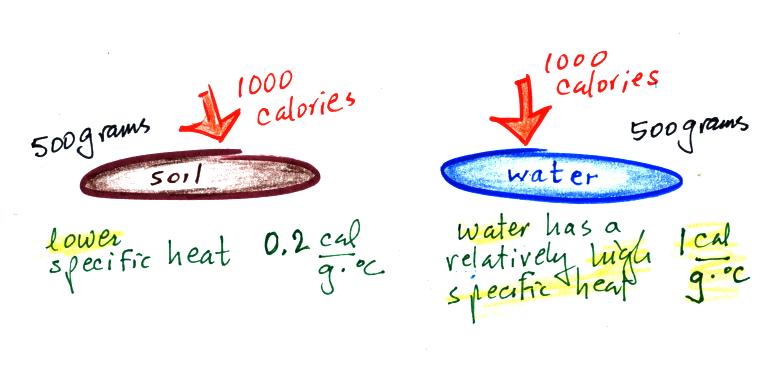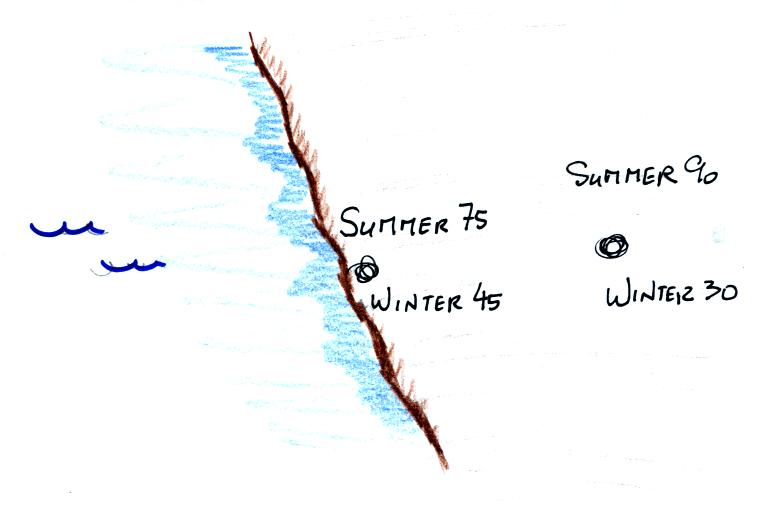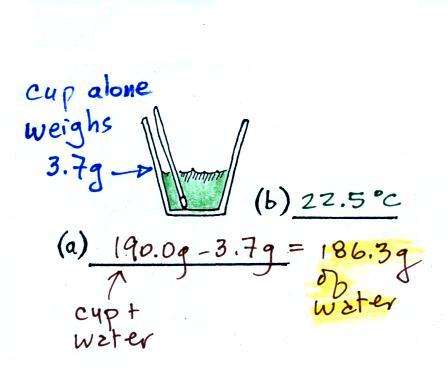Friday Feb. 17, 2012
click here to
download today's notes in a more printer friendly format
"Nothing Else
Matters" from Apocalytica before class this afternoon.
Quiz #1 has been graded and was returned in class today. Please
check carefully to see that your quiz was graded correctly and hang on
to this quiz and any other work that is returned to you during the
semester. Don't throw anything away until you've received and
agree with your final grade at the end of the semester.
A new Optional
Assignment is online. You can earn extra credit and even a
green card (see the fine print on the assignment itself). The
assignment is due at or before the start of class next Friday (Feb. 24).
During the next couple of weeks we
will be moving into a completely different topic and will be concerned
with energy,
temperature, heat, energy transport, and
energy
balance between the earth, atmosphere, and space.
It is easy to
lose sight of the main concepts because there are so many
details. Most of the following figures are found on pps 43&44
in the photocopied
ClassNotes.
Types
of
energy
We will learn the names of several
different types or forms of
energy.
Kinetic energy is energy of motion. Some examples (both large
and microscopic scale) are mentioned
and sketched above. This is a relatively easy to visualize and
understand form of energy.
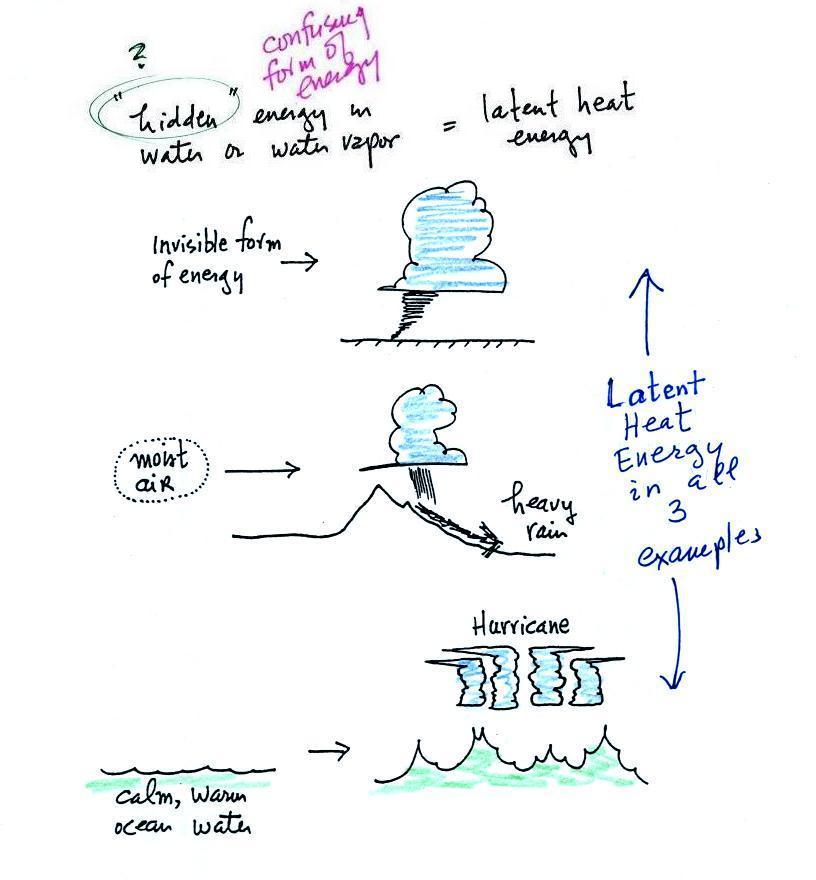
Latent heat energy is perhaps the most
underappreciated and most
confusing type of energy. The word latent refers to energy that is
hidden in water and water vapor. The hidden energy emerges when
water vapor condenses or water freezes (the energy had been added
earlier when ice was melted or water was evaporated).
Radiant energy is a very important form of energy that was for
some
reason left off the original list in the ClassNotes. Sunlight is
an example of
radiant energy that we can see and feel (you feel warm when you stand
in sunlight). There are many types of radiant energy
that are invisible (such as the infrared light that people emit).
Electromagnetic radiation is another name for
radiant energy.
Energy
transport
Four energy transport
processes are listed below.

By far the
most important process is at the bottom of the list above. Energy
transport in the form of
electromagnetic radiation (sunlight is a common
form of electromagnetic radiation) is the
only process that can transport energy through empty space.
Electromagnetic radiation travels both to the earth (from the sun) and
away from the earth back into space. Electromagnetic radiation is
also
responsible for about 80% of the
energy transported between the ground and atmosphere.
You might be
surprised to learn that latent heat is the second most important
transport process.
Rising parcels of warm air and sinking parcels of cold air are
examples of free convection. Because of convection you feel
colder or
a cold windy day than on a cold calm day.
Ocean currents are also an example of convection. Ocean currents
transport energy from the warm tropics to colder polar regions.
Convection is a 3rd way of causing rising air
motions in the atmosphere (convergence
into centers of low pressure and fronts are other 2 ways we've
encountered so far)
Conduction is the least important energy transport at least in the
atmosphere. Air is such a poor conductor of energy that it is
generally considered to be an insulator.
Energy
balance
and the
atmospheric greenhouse effect
The next picture
(the figure in the ClassNotes has been split into three
parts for improved clarity) shows energy being transported from the sun
to
the earth in the form of electromagnetic radiation.
We are aware of this energy because
we can see it (sunlight
also contains invisible forms of light) and feel it. With all of
this energy arriving at and
being
absorbed by the earth, what keeps the earth from getting hotter and
hotter? If you park your car in the sun it will heat up.
But there is a limit to how hot it will get. Why is that?
It might be helpful when talking about energy balance to think of a
bank account. If you periodically deposit money into your account
why doesn't the balance just grow without limit. The answer is
that you also take money out of the account and spend it. The
same is true of energy and the earth. The earth absorbs incoming
sunlight energy but also emits energy back into
space (the orange and pink arrows in the figure below)

Energy is emitted in the form of
infrared light is an
invisible form of energy (it is weak enough that we
don't usually feel it either). A balance
between incoming and outgoing energy is achieved and the earth's annual
average temperature remains constant.
We will also look closely at energy transport between the earth's
surface and the atmosphere (see the figure below). This is where latent
heat energy transport,
convection and conduction operate (they can't transport energy beyond
the atmosphere and into outer space).
That
is
also
where
the atmospheric
greenhouse functions. That will be a important goal -
to
better understand how the atmospheric greenhouse effect works.
The greenhouse effect is getting a
lot of "bad press". If the earth's atmosphere didn't contain
greenhouse gases and if there weren't a greenhouse effect, the global
annual average surface temperature would be about 0 F (scratch out -4 F
and put 0 F, it's easier to remember). Greenhouse gases raise
this
average to about 60 F and make the earth a much more habitable
place. That is the beneficial side of the
greenhouse effect.
The detrimental side is that atmospheric greenhouse gas concentrations
are increasing. This might enhance or strengthen the greenhouse
effect and
cause the earth to warm. While that doesn't necessarily sound bad
it could have many unpleasant side effects. That's a subject
we'll explore briefly later in the semester.
When you
add energy to an object, the object will usually
warm
up (conversely when you take energy from an object the object will
cool). It is relatively easy to come up with an equation that
allows
you to figure out what the temperature change will be (one of those
equations I'll probably write on the board during the next quiz if you
ask me to - try
to understand it, you don't have to memorize it).
The temperature change, ΔT, will
first depend on
how much energy was added, ΔE. This is a
direct proportionality, so ΔE is in the
numerator of the
equation (ΔE and ΔT are
both positive when energy is added,
negative when energy is removed)
When you add equal amounts of energy to large and small pans
of water, the small pan will heat up more
quickly. The temperature change, ΔT, will
depend on the
amount of water, the mass. A small mass will mean a large ΔT,
so
mass
should
go
in
the
denominator of the equation.
Different materials
react differently when energy is added to them. A material with a
large specific heat will warm more slowly than a material with a small
specific heat. Specific heat has the same kind of effect on ΔT
as
mass. Specific heat is sometimes called "thermal mass" or
"thermal capacity." You can think of specific heat as
being thermal inertia - a substance with high specific heat, lots of
thermal inertia, will be reluctant to change temperature.
Here's an important example that will show the effect of specific
heat (middle of p. 45). I've changed the numbers from the example
shown in class.
Equal
amounts of energy (1000 calories, note that calories are units of
energy) are added to
equal masses (500 grams) of water and soil. We use water and soil
in the
example because most of the earth's surface is either ocean or land.
Before we do the calculation, try to guess which material will warm up
the most. Everything is the same except for the specific
heats. Will water with its 5 times larger specific heat warm up
more or less than the water?
Here are the details of the calculation.
With its higher specific heat, the water doesn't heat up nearly as
much as the soil. If we had been removing energy the soil would
have cooled off more than the water also.
These different rates of warming of water and soil have
important effects on regional climate.
Oceans moderate the climate.
Cities near a large body
of water won't warm as much in the summer and won't cool as much during
the winter compared to a city that is surrounded by land.
The yearly high and low monthly average temperatures are shown at
two locations above. The city on the
coast has a 30o F annual range of temperature (range is the
difference between the summer and winter temperatures). The
city further
inland (assumed to be at the same latitude and altitude) has an annual
range of 60o F. Note that both cities have the same 60o
F annual
average temperature. We'll see a much more dramatic example of
the moderating effect of water on climate in a couple of weeks.
Here's another situation where you
can take advantage of water's
high specific heat to moderate "micro climate."
I did plant
some of my young tomato plants last weekend (this is a picture from a
previous year). It
still
can get
plenty cold enough at night in February or early March to kill tomatoes
(the brocolli
and lettuce in the background can handle a
light frost) so you have to protect them.

Here's one way of doing that.
You
can
surround
each
plant
with
a
"wall
o
water"
-
a
teepee
like arrangement that surrounds each plant. The cylinders are
filled with water and they take advantage of
the high specific
heat of water and won't cool as much as the air or soil would during a
cold
night. The walls of water produce a warm moist microclimate that
the tomato seedlings love. The plastic is transparent so plenty
of sunlight can get through.
Adding
energy to an object will usually cause it to warm. But there
is another possibility (bottom p. 45), the object could change
phase (change
from solid to liquid or
gas). Adding energy to ice might cause
the
ice to melt. Adding energy to water could cause it to
evaporate. We hurried through
this a little bit in class.
The equation at the bottom of the
figure above allows you to
calculate how much energy is required to melt ice or evaporate water or
sublimate dry ice. You multiply the mass by the latent heat, a
variable that depends on the particular material that is changing
phase. The latent heat of vaporization (evaporation) is the
energy required to evaporate 1 gram of a material.
If you add energy to or remove
energy from an object, the
object
will usually change temperature. You can calculate the
temperature change if you know the object's mass and its specific
heat. That's the equation we used in the example calculation
above. It's shown again below.
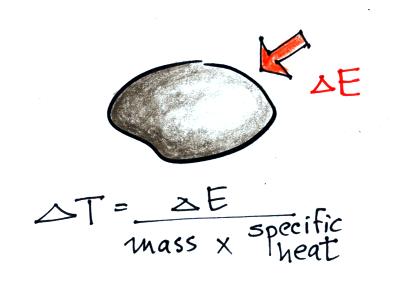
We conducted an experiment in the
last part of the class and we needed to be able to measure ΔE.
We'll stick a thermometer into the object and measure any changes in
temperature that occur.
If you know the mass and specific heat of an object and
measure a change in temperature you can use the equation above to
calculate how much energy was added to or removed from the object.
And on to the in-class experiment. A couple of
groups of students from
the class were nice enough to volunteer
to
perform the experiment (an offer of a green card might also have had
something to do with it).
The students that are doing Experiment #2 are doing something
similar, they are measuring the latent heat
of fusion of ice, the energy needed to melt one gram of ice.
You'll
find the following figure on p. 45a in the photocopied
Classnotes. This is pretty confusing even after I neatened it up
a little bit after class.
You'll
find the following figure on p. 45a in the photocopied
Classnotes. This is pretty confusing even after I neatened it up
a little bit after class.
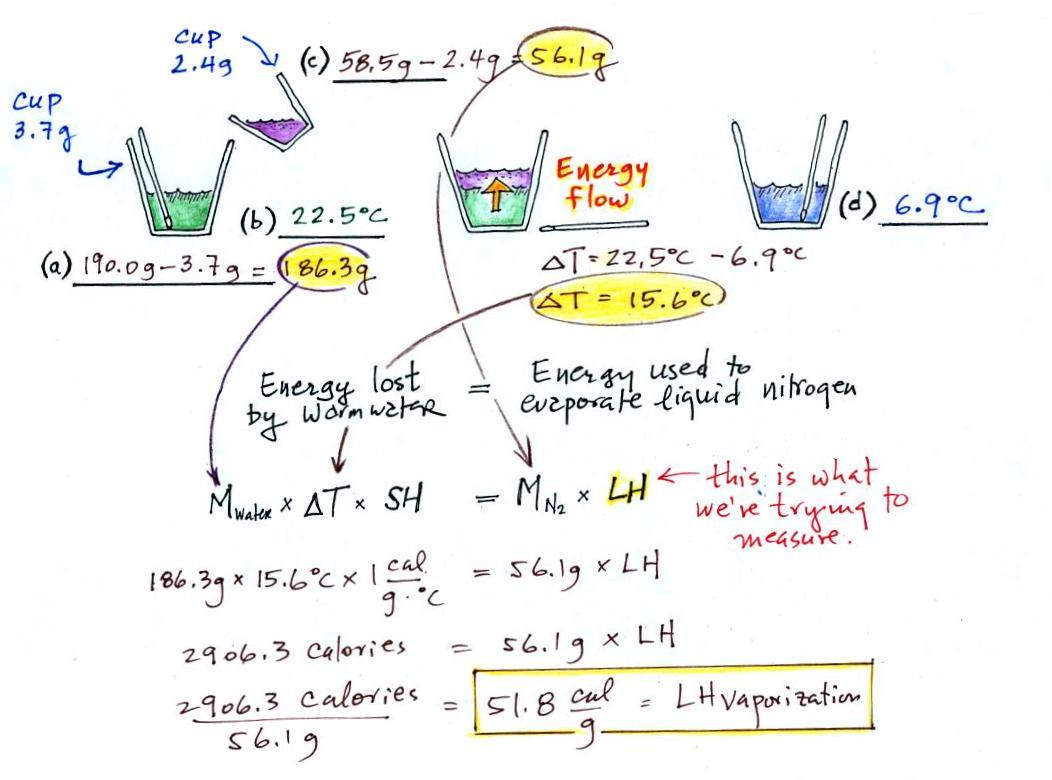
So here's a step by step
explanation of what the students did:
(a)
Some room temperature water poured into a styrofoam cup weighed
190.0g. The cup itself weighed 3.7 g, so they had 186.3 g of
water. The water's temperature was measured with the
thermometer and was
22.5 C (room temperature).
(b)
Some liquid nitrogen was poured into a second smaller styrofoam
cup. That weighed 58.5 g. Subtracting the 2.4 g weight of
the cup means we had 56.1 g of liquid nitrogen.
We don't need to measure the temperature of the liquid nitrogen
(doing so would probably destroy the thermometer). It had already
warmed as much as it can ( to -320 F or something like that). Any
additional energy added to the liquid nitrogen will cause it to
evaporate.
(c)
After the liquid nitrogen had evaporated the water's
temperature was remeasured. It had dropped to 6.9 C.
We started out with water that was 22.5 C, so that is a temperature
drop of 15.6 C.
It takes energy to turn liquid nitrogen into nitrogen gas.
The energy needed will be taken from the water (the red arrow below,
energy naturally flows from hot to cold).
Because the experiment was performed in an insulated sytrofoam cup we
will assume all of the energy taken from the water is used to evaporate
nitrogen. No energy flows into the room air or anything like
that. We will set the two equations above equal to each
other. This is an energy balance equation.
We know the mass of the nitrogen (56.1 g) and the water (186.3
g). We measured the ΔT (15.6 C) and we
know the specific heat of water (1 cal/g C). We substitute them
into the equation above and solve for LH, the latent heat of
vaporization of liquid nitrogen. Here are the details of the
calculation:
A
responsible & trustworthy student in
the class (though not a Buddhist monk it turns out) informed us that
the known value is 48 cal/g, so this measurement
was pretty close to the known value.


